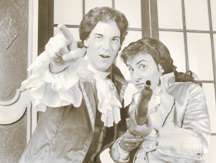

[ Metro | Metroactive Central | Archives ]
Figaro's Crazy Day
Valet to the Dolls: Mel Ulrich and Layna Chianakas in "The Marriage of Figaro"
The enduring class subversion of Mozart's 'The Marriage of Figaro'
By Philip Collins
Intrigues and trysts between aristocrats and working stiffs have long been staples of the opera buffa literature. Identity mix-ups involving the haves and have-nots are also common, with origins traceable to 16th-century Italy, when commedia dell'arte performances thrived upon such satirical devices.
Mozart's The Marriage of Figaro is clearly wedded to this tradition, and it is commonly referred to as an opera buffa. But the label is inadequate, like calling Swan Lake dance music. Mozart and librettist Lorenzo da Ponte exalted the comedic means of commedia dell'arte to new heights when adopting Beaumarchais' popular and controversial play Le mariage de Figaro, ou La folle journée ("the craziest day") to the opera medium.
There is no dearth of wit in da Ponte's setting, and the mixed- identity plot is certainly played to the hilt. But more important is the emotional power that the opera generates via farcical elements. It is an opera of sublime delight and poignancy, keyed to the human condition, yet unweighted by it.
This weekend, Opera San José opens a revival of its 1989 production of The Marriage of Figaro. Director Daniel Helfgot, who also helmed the 1989 production, identifies a number of elements that contribute to this opera's timeless appeal, chief among them Europe's political climate in 1786. Individual rights are endorsed heartily in the opera, while the royal order is, in turn, canned and shelved.
"There is a strong political message in Figaro," Helgot explains. "The French revolution was knocking on the door at the time. Beaumarchais had been battling censors for four years to get a crack in the window ... and don't forget that he helped supply arms to the Americans to fight the English." Because of its attacks on the upper classes, Beaumarchais' Figaro was banned, a decree that, thankfully, did not deter da Ponte's resolve to realize the work in operatic form.
"Da Ponte knew how to push through the courts," Helgot says. "He veiled the political messages, and said, 'I'm not doing Beaumarchais' play; I'm writing an opera with Mozart.' "
Da Ponte telescoped the play from five to four acts, removing five characters as well as the more pointed political jabs. The essential story, about Figaro, valet to Count Almaviva and Countess Rosina, and his forthcoming marriage to Susanna, the countess' maid, remained intact. "Da Ponte included his criticisms in very elegant ways," notes Helfgot. "Figaro sings, 'Dear Prince, I'll teach you to dance the capriole.' The capriole was a peasant dance, not a court dance."
Among the prime obstacles in the way of Figaro and Susanna's consummation are the conniving Almaviva, who wishes to exercise his royal right to sleep with his servant's bride on her wedding night; and Marcellina, a spinster determined to collect Figaro's debt to her by marrying him. Only later do we learn that Marcellina is Figaro's mother.
"You could sell this story to Geraldo; call it 'women who want to marry their sons,' " Helfgot kids. "If somebody went to the NEA for funding a new opera using this story, they'd be called communist deviates. We are able do this just because we set it in costumes from the past. It has a patina of time that coats the message like an aspirin. Hopefully, it will also hold up a mirror to ourselves."
You'd hardly expect as much from Neil Simon in Plaza Suite, and yet the madcap disguise bits and such in The Marriage of Figaro are hardly more elevated. Regardless of da Ponte's quality libretto, it is Mozart's music that really sets this opera apart.
"Mozart walks a shade of gray, a narrow line between drama and comedy," Helfgot says. "It's this balance that brings out the human element and makes Figaro readable at so many levels."
The final scene is one of the greatest miracles of human creation: a denouement that is cunningly prepared and yet revelatory every time it is experienced. Following a nocturnal escapade of traded identities, the disguises are removed and all pretenses with them. Revealed before one another amid the evening's darkness, the characters join together and sing an anthem of love.
"Mozart stops the world to prove that there is nothing more sublime than asking for forgiveness," concludes Helgot. "You can hear the brakes squeaking to end the farce, as if Mozart were saying, 'Stop, and listen.' "
[ Metro | Metroactive Central | Archives ]
This page was designed and created by the Boulevards team.

Photo by Scott Hinrichs
The Marriage of Figaro play Feb 10, 13, 15-17, 20, 22-24 at 8pm and Feb. 11, 18 and 25 at 3pm at the Montgomery Theater, Market and San Carlos streets, San Jose. Tickets are $32-$43. (408/437-4450)
From the Feb. 8-14, 1996 issue of Metro
Copyright © 1996 Metro Publishing and Virtual Valley, Inc.